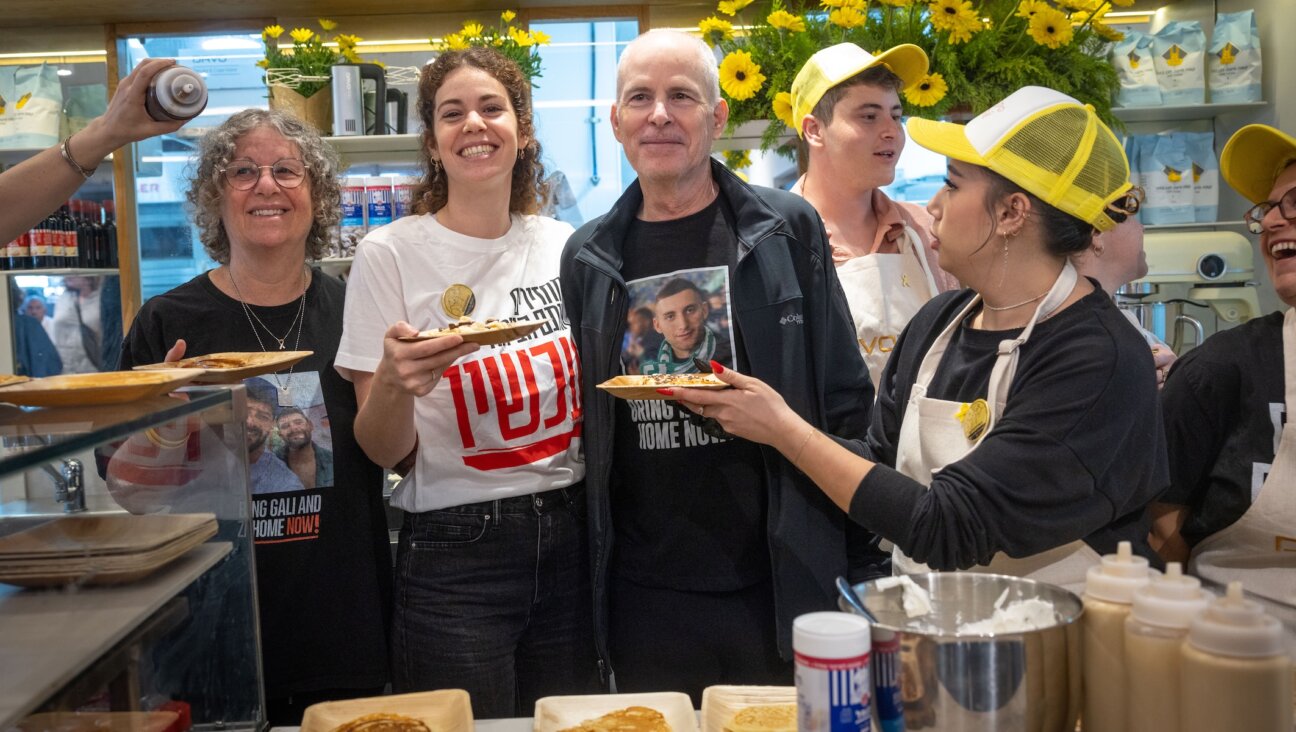A Blast From The Present Returning to the Catskills Past The Author Never Knew
Spring brings out the nostalgia fiend in me; the part that firmly believes Haggadas should hail Maxwell House and kids should hunt for the afikomen between plastic-covered couch cushions.
Yes, I romanticize the past — particularly the 1950s New York, kreplach-canasta-Catskills Jewish past, which I missed by a couple of decades and several states, growing up as I did in 1970s Chicago suburbia. I moved to New York hoping that somehow, despite the odds against me, I, too, could become a Dodgers-loving, brisket-braising, Coney Island-bathing Jewess. Maybe a little Yiddish could work its way into my conversations, nu?
No. It was all too self-conscious. For 20 years, Marjorie Morningstar’s era fox-trotted farther and farther away. There was no goose-shaped chopped liver for me. I was doomed to live in the blueberry-bagel present. After I had kids, I accepted the fact that every year around this time I’d be attending parent orientations for “Computers ’n’ Karate Camp.” That is, until I discovered the Jewish answer to Brigadoon:
The bungalow colony.
What’s a bungalow colony? That’s what I wanted to know when my friend Carol invited my family to visit her up in Monroe, N.Y., a few summers back. Like many New Yorkers, Carol grew up going to bungalow colonies and chuckled at our ignorance (my husband is from Chicago, too). “You’ve never been to a bungalow colony?” she asked. “Just come. You’ll love it.”
She neglected to add, “And once you do, your life will be changed forever.”
So we rented a car and drove up Route 17, passed a barnlike restaurant called the Red Apple Rest, and a few miles in as we trudged in from the parking lot — parking dirt, anyway — my husband and I literally did a double take. The place looked like it came straight out of a Norman Rockwell painting — if Rockwell had been born Normy Rosensweig: A hundred whitewashed cottages sat shtetl–close to each other and a big swath of grass ran down the middle. Clusters of ladies sat on mismatched lawn chairs discussing — yes! — last night’s canasta game. The men were smoking cigars. And the kids! Kids were zooming all over the place, banging screen doors, shouting, running around in packs. Carol’s children seized ours and immediately started showing them around: “This is our swing” (hanging from a tree, no less!). “This is our picnic table. This is the pool. This is the concession stand where we get candy.” (What, no charlotte russe?)
My kids disappeared down the path and Carol insisted we sit tight. They were safe here. No cars. No strangers. By age 3 or 4, children start wandering off with their friends, Carol told us, and ours just had. The only rule for grown-ups is that if the pack ends up at your bungalow during lunchtime, you have to feed all of them. That was the reason Carol had such a huge tub of peanut butter — and a freezer full of ice-cream sandwiches.
The rest of the day was spent in a daze of pleasure and disbelief, mixed with more than a dollop of envy: You mean you’ve been coming here for years? (Yes.) And anyone can join? (Of course.) You don’t have to know someone? (Don’t be ridiculous.) But does everyone already know each other and would we be out of place? (No!) Does it cost a ton of money? (About $4,000 for the summer.) What do you do with the kids all day? (This particular colony — Rosmarins — has a day camp, which Carol actually had attended as a kid, darn her!)
Okay, so: Who are all these people? Teachers, Carol said, plus a small cadre of her friends from Manhattan and a whole lot of older people who had drifted here over the years as their colonies closed.
Because that’s the sad truth, we learned: Of the hundreds of bungalow colonies that once thrived throughout the Catskills, most are dead or very different now, killed off by the three A’s – air-conditioning, airplanes and assimilation. Once people could stay cool in their homes or fly someplace fancier for the summer, they did. Moreover, once Jews no longer felt compelled to cluster, they didn’t.
Some of the colonies that managed to survive became exclusively Hasidic. Others were revived by Russian Jewish immigrants. But very few colonies besides the one we were visiting continue to exist the way they did in say, 1955, when a summer bungalow was the height of middle-class Jewish pleasure — and no one had heard of computers, much less computer camp.
What more can I tell you? Here was the chance I’d literally been dreaming of — the chance not only to step back in time, but also to take my family with me. We made our deposit a few days after that first visit and this summer with be our fifth at the colony. Every year we rent the same bungalow and every year our kids look forward to a summer that they think of as normal, not some strange time warp. They don’t know that in that great Jewish tradition we’re giving them the very joys we were deprived of as suburban ’70s children: A cramped little cabin. Neighbors so close you can hear them on the phone. Minimal supervision and a smattering of Yiddish.
The only thing missing? A goose-shaped chopped liver. But this Fourth of July — who knows, nu?
Lenore Skenazy is a columnist at the New York Daily News.
The Forward is free to read, but it isn’t free to produce

I hope you appreciated this article. Before you go, I’d like to ask you to please support the Forward.
At a time when other newsrooms are closing or cutting back, the Forward has removed its paywall and invested additional resources to report on the ground from Israel and around the U.S. on the impact of the war, rising antisemitism and polarized discourse.
Readers like you make it all possible. We’ve started our Passover Fundraising Drive, and we need 1,800 readers like you to step up to support the Forward by April 21. Members of the Forward board are even matching the first 1,000 gifts, up to $70,000.
This is a great time to support independent Jewish journalism, because every dollar goes twice as far.
— Rachel Fishman Feddersen, Publisher and CEO
2X match on all Passover gifts!
Most Popular
- 1

Film & TV What Gal Gadot has said about the Israeli-Palestinian conflict
- 2

News A Jewish Republican and Muslim Democrat are suddenly in a tight race for a special seat in Congress
- 3

Fast Forward The NCAA men’s Final Four has 3 Jewish coaches
- 4

Culture How two Jewish names — Kohen and Mira — are dividing red and blue states
In Case You Missed It
-

Fast Forward Cornell pro-Palestinian student leader opts to leave US, as Columbia ‘self-deportee’ makes her case to return
-

Fast Forward ‘Need a final solution’: Podcast host calls for mass deportation of U.S. Jews
-

Fast Forward Britain’s Tate to return Nazi-looted painting to heirs of Jewish art collector
-

Fast Forward 3 sentenced to death for murder of UAE Chabad rabbi
-
Shop the Forward Store
100% of profits support our journalism
Republish This Story
Please read before republishing
We’re happy to make this story available to republish for free, unless it originated with JTA, Haaretz or another publication (as indicated on the article) and as long as you follow our guidelines.
You must comply with the following:
- Credit the Forward
- Retain our pixel
- Preserve our canonical link in Google search
- Add a noindex tag in Google search
See our full guidelines for more information, and this guide for detail about canonical URLs.
To republish, copy the HTML by clicking on the yellow button to the right; it includes our tracking pixel, all paragraph styles and hyperlinks, the author byline and credit to the Forward. It does not include images; to avoid copyright violations, you must add them manually, following our guidelines. Please email us at [email protected], subject line “republish,” with any questions or to let us know what stories you’re picking up.














